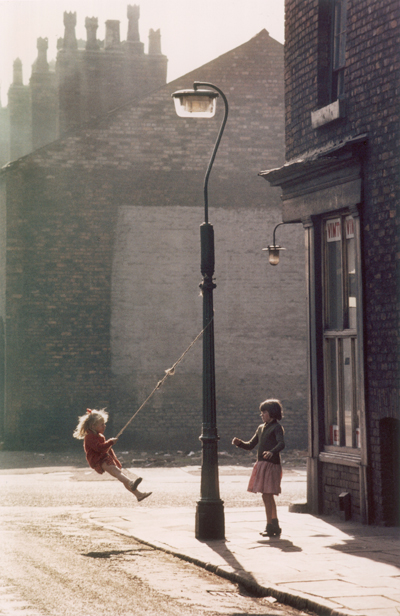|
The street photographer’s images of Manchester’s poorest districts in the 1960s and 70s exposed the pressures on both the built environment and the communities living within it “I never posed my pictures, I shot scenes as I found them,” Shirley Baker said of her photography – an approach clearly illustrated by a quasi-retrospective of her work at the Photographer’s Gallery. I say quasi, because rather than presenting an extensive cross-section of all her work, the show concentrates on the most recognised collection from her portfolio, and the one that best captures her ethos: her documentation of the working-class communities in Salford and Manchester from 1961 to 1981. Baker, who died last year, was born in Salford in 1932 and worked as a photographer and writer for several magazines and newspapers over her lifetime. The photos she became best known for, however, were mostly taken for her own enjoyment, rather than on commission.
Hulme, 1965 One of the only female street photographers in the UK at the time, Baker shed light on the relationships between the communities and the estates they lived in. Influenced by the likes of Robert Frank and Henri Cartier-Bresson, her photographs have a sense of planned spontaneity, with the setting seemingly preordained, but the human subjects within these frames acting independently and naturally. A sense of wit and humour shines through in her work, not just in the comical expressions and actions of her main characters, but also because of the supporting role played by the terraced houses and scrawled graffiti, which provide context and tone. In one photograph, a delivery man stands outside a row of houses talking to the locals. Framing this rather mundane activity are houses that have either been abandoned, or had their owners evicted – identified by the letters “EX” sprayed by the council beside the doorframes and, more obviously, the broken windows and crumbling walls. In another, a group of laughing boys play football with a protest-graffiti covered brick wall in the background. These photographs reveal how these groups of people would have interacted with each other and their neighbourhood.
Hulme, 1965 The photographs were taken at a time when the area was undergoing great redevelopment, as the Manchester councils tore down terraced houses to make room for larger “modern” low-rise flats in areas such as Salford and Hulme. These optimistic, brutalist affairs (such as the infamous Hulme Estate) were an attempt to solve the housing crisis in the Manchester area at the time. However, within 20 years, due to poor construction, high crime rates, and pest infestations, many of these buildings went the same way as their terraced forefathers. The title of Baker’s 1986 exhibition, “Here Today, Gone Yesterday”, neatly encapsulates this idea of a resilient community in the midst of extinction. The exhibit is thematically arranged, which has allowed the curators to group together sporting children, conversing elderly and decrepit architecture from across the span of the series. The thematic, as opposed to chronological, grouping enables a better understanding of the photographs, as we can identify recurring behaviours and habits. One grouping highlights the improvised use of the houses and street facilities, such as a makeshift swing, or a cot hanging from the doorframe. Another, focuses on elderly “loitering” men, whose diminished role in the local community has led to them spending their days on street corners and outside shops. As a whole, the collection shows a close tie between people and place, and an open community who interact on the streets, rather than shying away inside their homes. Street photography of this period can often stray down a nostalgic path. But Baker’s photography provides an honest and entertaining platform from which to reflect on a seemingly authentic version of our past. |
Words Julius Ingemann Breitenstein
Images Shirley Baker
Shirley Baker: Women, Children and Loitering Men
Images Shirley Baker Estate, Mary Evans Picture Library |
|
|




















